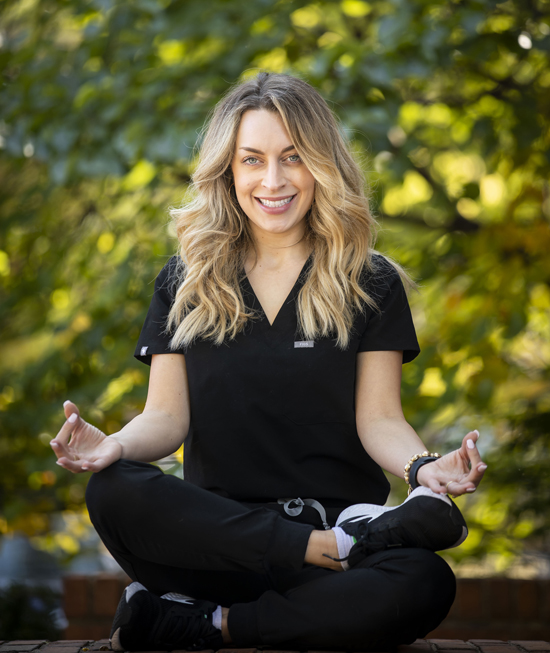by Matt Batcheldor
Julie Stavas, RN, has found a way to marry two of her passions — psychiatric nursing and yoga — at Vanderbilt Psychiatric Hospital (VPH). About once every week, she leads trauma-informed yoga therapy to a group of five to 10 patients for 30 to 45 minutes.

Stavas, a certified yoga instructor trained in trauma-informed yoga therapy, started the small group yoga in July. As a VPH float nurse, she brings the therapy to different units, including drug detox, mood disorder, acute psychosis, stepdown, geriatric and adolescent populations.
In a strange way, COVID-19 was indirectly responsible for the therapy. Before the pandemic, Stavas taught yoga at various yoga studios around Nashville.
“They all closed down,” she said. “I wanted to keep teaching and I thought, why not teach at Vanderbilt to patients who need it?”
Stavas sought and received approval for the class from Avni Cirpili, DNP, RN, chief nursing officer of VPH. “I was very excited by the proposal because it brings a new evidence-based activity to VPH for patients who have experienced trauma,” he said.
Instead of wearing yoga pants, she wears scrubs. And instead of a yoga studio, it’s a group meeting room with the furniture pushed to the side.
This yoga therapy is a little different than a typical yoga class. It considers patients who have lived through certain traumatic experiences. For example, patients who have been human trafficked may be triggered by the word “relax,” which is often used by the abusers who trafficked them. “Being mindful of the words that come out of my mouth is the base of trauma-informed yoga,” Stavas said.
“Certain poses, too, can be very triggering for patients because yoga is all about opening up the body and being present in the moment, and when somebody has gone through trauma, a lot of times they want to escape the body. But trauma-informed yoga teaches you how to come back into your body, to be present in your body and know that it’s safe to be in your body.”
A typical class begins in Child’s Pose. “I tell patients to bring their big toes to touch, knees out wide, forehead on the mat. This is called Child’s Pose and it’s a very grounding pose. I remind patients that they are safe on their mat and to leave all their external troubles off of the mat for the next to 30–45 minutes.”
Breathing exercises follow to slow down her patient’s thoughts as they get deeper into the class. The class ends with a 5-minute meditation.
After two months of holding the sessions, she’s already seeing the benefit in her participants.
“I see definitely more calmness in my patients,” she said. “I always call it the post-yoga glow. Just being able to feel more present, seem less anxious. Yoga is a lot about connection, so just being able to connect with another body in the room. Interpersonal relationships have definitely developed in the yoga room.”
Stavas said she became interested in yoga in college in Chicago, when she didn’t have a lot of money and she found a studio that offered free classes on Saturdays. After college, she moved to Nashville and Vanderbilt, and after a couple of years working in the ICU, she found her passion in the psychiatric hospital.
“I’m hopeful for my patients, whether they practice yoga or not at home, I want them to always know that their bodies are a safe space,” she said.












